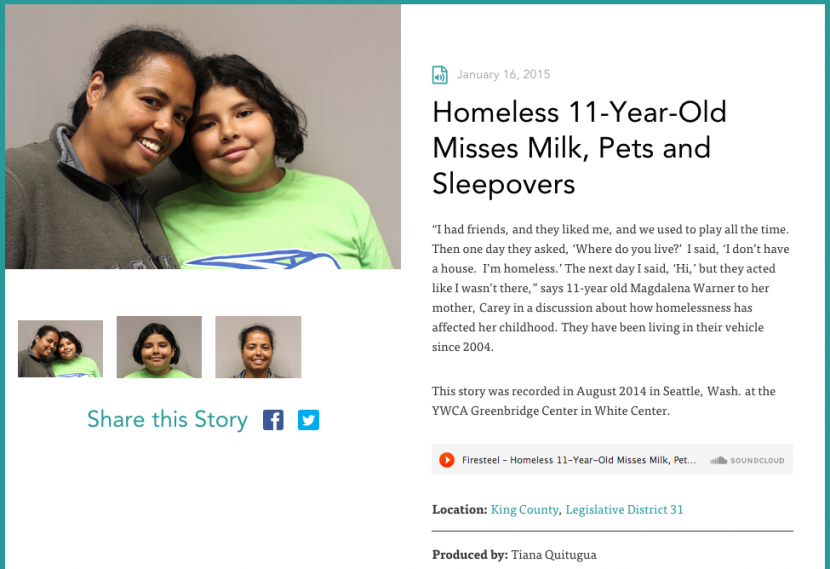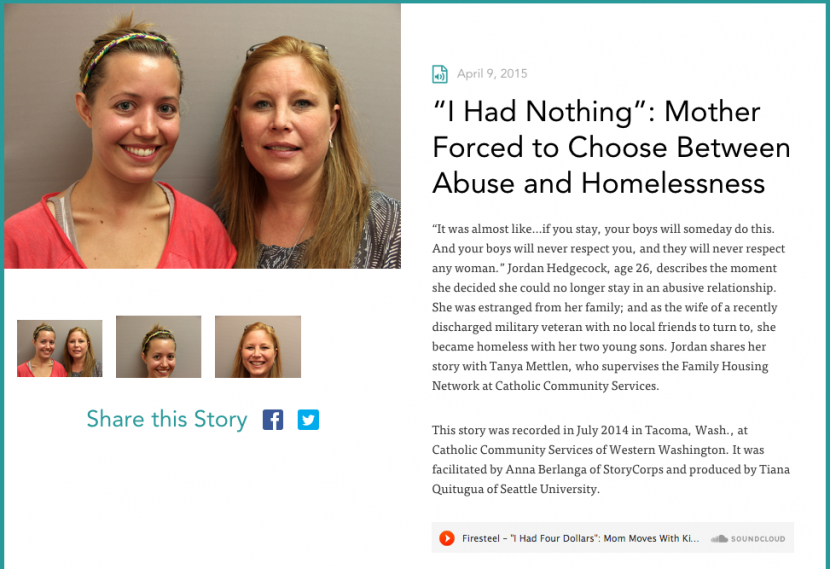Written by Haley Jo Lewis and Tiana Quitugua, project assistants, Seattle University Project on Family Homelessness
A young girl, Magdelena (Maggie), tells her mother what it’s like to be homeless – how her friends reacted when they found out, what she misses most, and how it can be hard to do class assignments while living in a car. As we listened to stories like this from the StoryCorps “Finding Our Way” project, we were faced with a massive task: How to honor that little girl – and everyone else who told their stories – and produce a piece that is a powerful advocacy tool.
Maggie’s story is a favorite for many, including Tiana, who produced it. What makes this story so powerful is that an 11-year old is the storyteller. Tiana says she still gets emotional thinking about Maggie’s struggle.
Editing these touching stories was frustrating, but so empowering to produce, knowing that the end product will impact others as it has impacted us. Though both Maggie and her mom, Carey, interviewed each other, deciding to tell the story from Maggie’s perspective worked well in the end and greatly helped Tiana edit the story to the appropriate length.
“Most of our motivation to produce these stories was hearing how moving they were,” Tiana says, “and understanding that I was the person to compile and share it with others, who would hopefully be moved to action.”
Between the two of us, we have edited 15 “Finding Our Way” stories. We’re excited to share what we’ve learned along the way! This project is a valuable advocacy tool, and we hope that you learn from our experience. Below you will find suggestions for how we produce stories — before, during, and after the editing process.
- If you’re not familiar with a StoryCorps-style recording, listen to some at storycorps.org or firesteelwa.org/storycorps. You should also read StoryCorps’s editing guide.
- Take a step back — think about what makes this story unique and special. What part of the story do you want to tell?
- Think about how the conversation might relate to key issues or legislative items. For example, did the storytellers have difficulty finding housing because of structural barriers?

Stories on the Firesteel site are organized by specific areas and topics for easy navigation. These tags can help you choose a story that best fits your advocacy outreach. - Listen to the full audio recording while simultaneously reading over the transcript. Pause along the way to take notes about the best parts of the audio. Highlight any key sections that you want to be sure to include in your edited piece.
- Remember that you don’t need to tell a whole life story. It’s okay to capture as few as one or two memorable moments.
- Decide what audio editing software you want to use. StoryCorps recommends Audacity; we used GarageBand on our laptops.
- Start and end with a powerful statement. Think of the arc of the story.
- Decide how long you want the finished story to be. A rough estimate is that one page of the transcript equals about two minutes of audio. StoryCorps allows you to use up to eight minutes, no more; we recommend two or three minutes.
- Start the editing process by making a “script” from the transcript. Don’t start editing audio till you have a good first draft on the transcript.
- Start cutting sections that are not relevant to the story you’re trying to highlight. How to make cuts:
- You can delete the introductions and backstories in the story, and incorporate those into a written introduction.

Here is an example of a brief introduction that includes names, background information, and other important information that we edited out of the audio. - If content raises more questions than it answers, or needs more information not found within the recording or written intro, delete it.
- If something would require extensive fact checking, cut it — unless you have a team of fact-checkers.
- Remember that pauses take up time, so you can eliminate those that you feel are too lengthy. You can also excise portions where a storyteller begins a sentence then starts over, or uses “um,” or other extraneous words.
- You can delete the introductions and backstories in the story, and incorporate those into a written introduction.
- Always make cuts to both the transcript and audio file to have an updated transcript that reflects your audio. Keep backup copies of both!
- Make your story a dialogue, with both people talking or responding to questions.
- It’s helpful to identify the most compelling portion of the recording and make that the main focus, then build around it. Examples:
- A structural barrier related to homelessness that someone overcame
- A vivid example of a contributing factor to homelessness
- A moving or inspiring moment in time
- A demonstration of family love and admiration in times of struggle
- A really unusual situation
- Struggles trying to stay in school
- Incredible barriers that were overcome
- Tell the story through a social-justice lens. The goal is to build compassion by sharing stories of the people affected by homelessness and putting a face (or voice) on the issue. Ask yourself:
- Does this story challenge pervasive stereotypes?
- If I were the storyteller, is this how I would want my story edited?
- We need to use compassion and sensitivity, and avoid sensationalism. It is important to honor the storyteller, not just tell the story.

This story is an example of how compassion and awareness can be created by giving a face to the issues of domestic violence and family homelessness. - If the storyteller specifically names children, try to avoid sharing their names and ages — unless they are one of the storytellers, of course.
- Getting another set of eyes and ears on your piece will also help in the elimination process.
- It is helpful to set a halfway and final goal for length. Example: On the first edit, we try to cut the transcript in half; on the next, half again.
- Write an introduction that gives context to the edited version of the story.
- Request approval from the main storyteller before posting the story. Firesteel can help with this.
- Put the audio into mono before posting.
- Be sure that you are adhering to StoryCorps guidelines, which stipulate that all edited segments should:
- Adhere to the overall tone of the interview.
- Be posted online in a manner that cannot be downloaded by listeners, only streamed.
- Last no longer than eight minutes.
- Be unique, truthful, and respectful.
- Be accompanied by the following credit language or alternative language approved by StoryCorps: “Produced by [INSERT NAME OF PRODUCER] with interviews recorded at StoryCorps, a national nonprofit whose mission is to provide Americans of all backgrounds and beliefs with the opportunity to record, share, and preserve the stories of our lives. storycorps.org.”
- Alert StoryCorps and Firesteel whenever you publicly post a story online or publicly display your edited interview. You can do so by emailing stories@firesteelwa.org with any relevant links or descriptions of your content.
- Share, share, share! Post your story on your website and promote it via social media, your newsletter, and even your email signature.
We acknowledge and know all too well that producing a story is no easy task. We hope these guidelines help you feel confident in utilizing these amazing tools for advocacy in a way that is respectful, honest, and effective.


